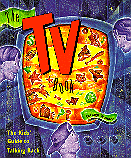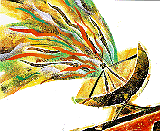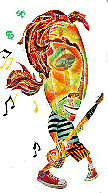


|
The TV Book: The Kids Guide to Talking Back.
Shelagh Wallace. Illustrated by Lorraine Tuson and Brian Bean.
Grades 9 - 12 / Ages 14 - 17. **/4
|

excerpt:
"Most researchers believe that watching violence on TV makes TV viewers, especially kids, act more violently in their own lives. Many studies show that, after you watch a violent program, you are more likely to imitate what you have just seen on TV - shoving and checking like a hockey star, kicking like a Power Ranger, or wrestling like your hero on the World Wrestling Federation. Watching people you admire and respect behaving in violent ways makes it seem all right for you to copy their behaviour."
 The TV Book is a collection of articles and profiles which attempts to provide teens with knowledge about television and thus, to empower them so that they will make intelligent choices and responses.
The TV Book is a collection of articles and profiles which attempts to provide teens with knowledge about television and thus, to empower them so that they will make intelligent choices and responses.
Author Shelagh Wallace shows readers television behind the scenes with her revealing profiles of actors, an advertising research president, students who conducted their own advertising experiments, and a thirteen-year old girl who, after her sister was murdered, took her pleas to stop TV violence to the Canadian broadcasting industry.

Though the colourful and almost cartoonish illustrations are a bid to reach out to younger kids, the content is more suitable for older teens and even beyond. Most young people will not likely choose to read this particular book unless they're writing a school report, a speech, or looking for some way of talking back to or at the system . From a research perspective, the book has no searchable index, although there is a table of contents. The appendix refers the teen to TV lingo ("tele wise words") and other useful tidbits such as "what is public tv?"; "what is a network?"; the Canadian Broadcast Code; Guidelines for Advertising to Children; and Canadian and American addresses where teens may direct their questions and comments.
Wallace begins the book by quoting a number of uncited statistics for her readers. She writes that researchers, and studies show that between 1982 and 1992 only 33.3% of all characters on American television programs were female and 90% of the actors were white. Another interesting but uncited statistic says that heavy TV viewers think a cop kills up to 50 people a year, whereas a real-life police officer uses his or her gun far less often - on average, once every 27 years.
Any older teen using The TV Book for research would have to sift through the "Acknowledgments" to find possible original sources. Most teens would not of their own volition read the book from cover to cover, but would head straight for the pertinent chapter.
It is difficult to take The TV Book seriously. There are no descriptive blurbs or raving reviews from any sources. The reader never has a sense of where this book is coming from (though Wallace herself says it is just a starting point) . More importantly, the reader does not see an actual photograph of the author and/or illustrators and knows nothing about their backgrounds, their credentials, previous publications, and current affiliations, all vital information for helping students determine the validity of what they are reading.
Recommended with reservations.
Floyd Spracklin is an English Language Arts Department Head and teacher at G.C. Rowe Junior High School in Corner Brook, NF. He has been teaching, writing, and reviewing literature for twenty-five years. Floyd has published a number of short stories, essays, and poems in Canadian magazines.

If you would like to order The TV Book: The Kids Guide to Talking Back please fill out the form below:To comment on this title or this review, send mail to cmeditor@mts.net.
Copyright © 1996 the Manitoba Library Association. Reproduction for personal use is permitted only if this copyright notice is maintained. Any other reproduction is prohibited without permission.
Published by
The Manitoba Library Association
ISSN 1201-9364
AUTHORS |
TITLES |
MEDIA REVIEWS |
BOOKSHELF
BACK ISSUES |
SEARCH |
ORDER |
HOME